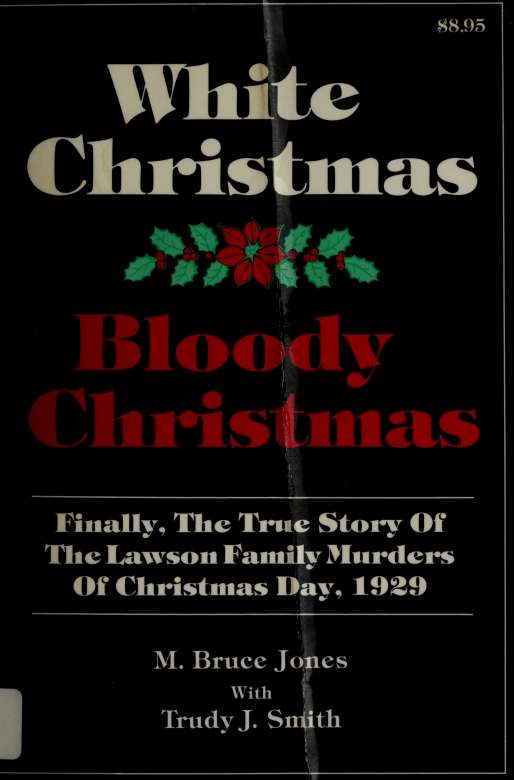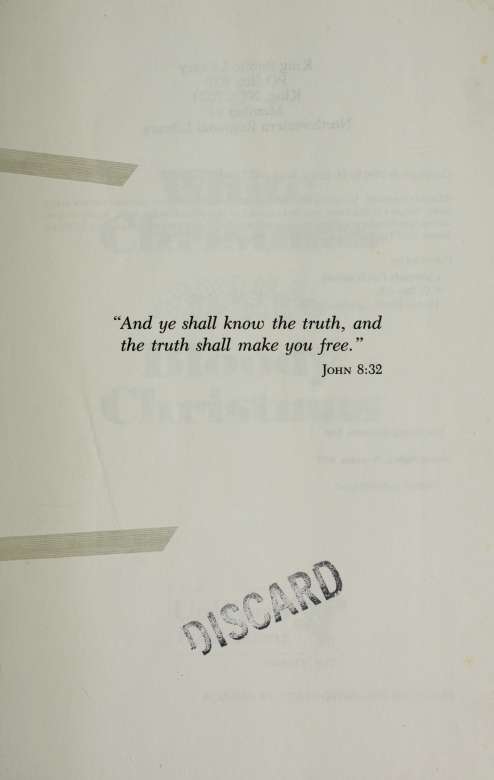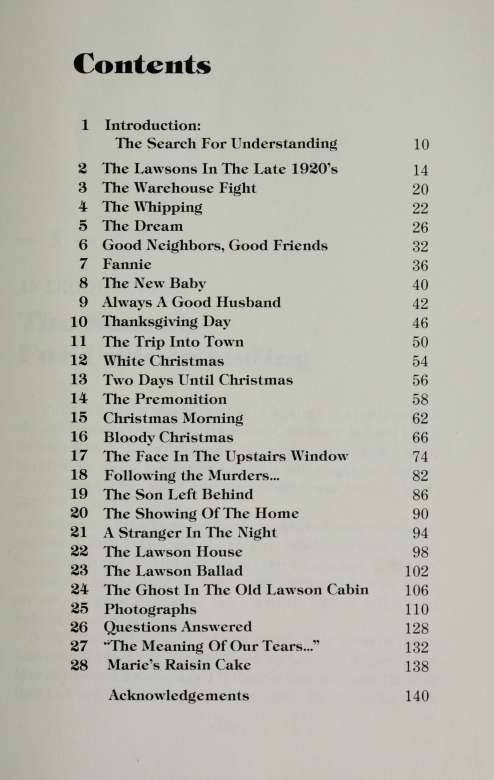White Christmas, bloody Christmas
Read White Christmas, bloody Christmas Online
Authors: M. Bruce Jones,Trudy J Smith
Tags: #Lawson family, #Murder


This book made available by the Internet Archive.




Digitized by the Internet Archive in 2013
http://archive.org/details/whitechristmasblOOjone
On The Family Tombstone...
"Not now, but in the coming years, It will be in a better land:
We'll read the meaning of our tears And then, sometime, we'll understand."
We dedicate this book to the memories of all the victims. But especially to:
Carrie, Mae Bell, James, Raymond, and Mary Lou...
They were so very young to have
died this way, and much too innocent
to ever have understood why.

age2; and in her mother's arms, little Mary Lou Lawson, age 4 1/2 months. Buried here also was another son, William, who died at age 6 of pneumonia. From William's original grave, this massive one had been created. The additional space was donated by Mr. Browder, who owned Browder Cemetery. Behind this large grave was the resting place of Fannie and Charlie's oldest son, Arthur.
Charlie Lawson and his family were simple, average, hardworking people. They were regular members of the Primitive Baptist Church in Walnut Cove. Until that tragic Christmas Day, they had seemed no different than any other rural North Carolina family you would have met unless you lived close by. Neighbors had been becoming increasingly aware that there was some type of problem in the family. Even though they were having problems, no one would have dreamed that something as horrific as this would befall the Lawson family on that tragic Christmas Day.
As we studied the grave, we wondered to ourselves of the lives these children might have had if they had been able to live them. As we studied the names and dates, I noticed that little Mae Bell Lawson and I share the same birth date: May 18. We were born exactly one year apart. I have been able to live my life while she has slept in this lonely spot for sixty years—forever only seven years old.
We had so very many questions, yet the only answer was the steady drip, drip of the summer rain. It would tell nothing as it gently rolled from the drooping fingers of the old oak that brushed against the mildewed tombstone. The huge grave would give up none of its many secrets, none of its reasons, none of its understanding—and understanding is what I have always truly desired.
It was on this day that I began my search. I knew that many others must feel as I feel—that there is a need for the world to finally know the truth about this sad Christmas Day of so long ago. I hoped that I could fulfill the prophecy of the inscription on the tombstone which reads..."We'll read the meaning of
-11
our tears, and then someday, we'll understand."
For many of us, the news of the tragedy was one of those things not unlike the news of Kennedy's assassination or the explosion of the space shuttle Challenger. Although I was only eight years old at the time, the horror of it would haunt me all my life and the desire to understand why it had happened would be something I would carry like an uneasy burden.
How sad that something like this had to happen. Even more so, our inability to learn from whatever mistakes Charlie Lawson made that carried him to this extreme height of madness and desperation.
What you will read in the pages of this book is a collection of the memories and handed down stories of that Christmas Day and of Lawson family members themselves.
For the sake of readability, it was necessary to recreate some portions of the Lawson story through imaginative writing. After sixty years, the memories of exact conversations and small details have faded, and obviously, the passages dealing with the thoughts and conversations of the victims could never have been written without some small risk of deviation. However, each portion of the book is based on our extensive interviews with family, friends,and acquaintances of the Lawson family, and are carefully rendered representations of actual events that took place. We feel confident that we have remained faithful to the Lawson story as it unfolded more than sixty years ago.
Most of these country farmers had little knowledge of stocks or bonds or the current financial trends—they only had their yearly hopes for success in their fields and ultimately the tobacco market. When Black Thursday fell on the nation October 24, 1929, most of the poor farmers couldn't immediately feel any difference. Their first concern was the effect of that year's drought. The Great Depression did not come upon the country side like a big blow out. It crept up on everyone somewhat like a slow leak. Finally the financial wheels of the country would grind to a heavy halt, crushing the hopes of people everywhere—rich and poor alike.
It was at the beginning of this painful era that the Lawson tragedy took place. A time when the world was poised on the brink of great turmoil and great social change. The country side was quiet, peaceful, and unsuspecting.
Cars were popular and highly desired, but still had not fully replaced the horse or mule-drawn wagons and buggies that traveled the country roads. Every farmer wanted to own a truck. In the two years before the murders, Charlie Lawson had acquired three older models. Pavement was something rarely seen anywhere in the rural areas of the country, and many of the small towns still had dirt main streets.
For the average rural farming family of the area, each day was filled with the labors of basic survival. Most of the ladies had only one or two really good dresses. Their one pair of high top lace-up shoes was expected to last a full year. Gaily patterned flour sacks were often used to make dresses for the girls. Almost everything a family used was grown or made on the farm. Gardens were grown to fill the canning jars for the winter; animals were grown and slaughtered to provide meat. This was the life the Lawson family led—simple and filled with hard work.
Because his brothers, Marion and Elijah had already moved into the Germanton area, Charlie and Fannie had taken interest in leaving Lawsonville and moving there, too.
They had been optimistic when they piled their children
-15-
and belongings into their old covered wagon to make the move. It was also encouraging to have neighbors willing to help. Mr. Squire Watts and his son volunteered to drive their own wagon back from Lawsonville with a load of furniture to help the new neighbors out.
They had believed they could make the fifteen mile trip in one day, but the rutted country roads were muddy from a previous rain and the trip became painfully slow. Darkness overcame them and forced them to camp along the road for the night.
It had been a long, weary day for the entire group, and Fannie was faced with both adults and tired children who were hungry. They searched the tightly packed wagon and found a couple of jars of canned blackberries.and Fannie had wrapped a large piece of leftover corn bread from a previous meal and brought it with them. This is what the group shared as their supper that evening as they sat around the small campfire.
After this initial trip into the area, Charlie and his family lived and farmed in rental or tenant situations. This was not always the best way to earn a living as a farmer, and times were hard for the family during these years.
In April of 1927, Charlie and Fannie entered into an agreement to purchase their own farm on Brook Cove Road. It was a good, fertile farm but the house was a small, rundown, two-hundred-year-old cabin. Still, the Lawsons agreed to purchase the farm for the amount of $3,200.00. The payments were to be made at a rate of $500.00 per year until the debt was paid in full. In the first season or two of farming, Charlie and his family would begin to be much better off financially...
Once the transaction to buy the farm was complete, Charlie and Fannie began their task of making it liveable. Fannie and Marie, who was then fifteen years old, scrubbed and whitewashed the inside of the old cabin while Charlie and seventeen-year-old Arthur repaired the exterior. They had to
-16-
remove the old shutters and replace them with regular glass windows. The kinching between the logs was crumbling and had mostly fallen away. This had to be replaced or the cold winds of winter would rob the house of any heat they could generate in it. Soon, the house was brought up to liveable standards and Charlie could turn his attention to the barns and other outbuildings.
Since tobacco was Charlie's primary livelihood, he was interested in delivering the highest quality leaves he could to the market. The leaves would spend some time waiting in the packhouse before it could be sold and the most effective way to keep the moisture content correct was to have a basement under the floor of the building. The moisture from the open ground would do a perfect job of maintaining the leaves until it was time to sell them. Soon after moving to the farm, Charlie began the job of digging a basement for his new tobacco packhouse.
Once the basement had been created, it was necessary to dig a drainage ditch so that excess water could escape from beneath the building. Charlie had paid little attention to the fence that ran a foot or two behind the packhouse. As he rythmically swung his maddock into the ground to break up chunks of earth, the very tip of it caught on the wire. The maddock recoiled and struck Charlie's forehead. The injury was nasty looking and Charlie went to visit the local family physician, Dr. Helsabeck, at his office in Germanton. The examination revealed that the injury was not as bad as it had first appeared. Several blood vessels had been severed in his scalp which caused profuse bleeding. Both of his eyes were black for a week or two. Later, after the murders, Dr. Helsabeck would examine Charlie's brain and state that this injury was probably not severe enough to have contributed to Charlie's actions.
There remain some persons who say Charlie Lawson was no different after the injury than he was before. There are also those who indicate that he did seem different. There had
been times, it is said, that Charlie would abruptly walk away from a conversation in mid-sentence—as if he had suddenly lost track of what was happening.
This injury was not the only health problem troubling Charlie. In the months before the murders, he had seen the doctor complaining of severe headaches and persistent insomnia. Fannie told friends of times that Charlie would jump wildly up from bed in the middle of the night and insist on checking his guns. Many nights he would ramble aimlessly around the house and barns, causing his wife to become fearful of him.
Charlie also had a reddish growth of some sort on his chest. It resembled a burn and was about the size of two hands laid side by side. On many occasions he had shown this mark to friends and commented on the pain associated with it. Certainly Charlie Lawson had more than one problem, and perhaps all of them played a part in his final actions. Charlie was quoted as having said to friends in a casual conversation a few months before the murders, "I wouldn't mind dying if I could only take my family with me..."
And what of Charlie's family—his wife and seven children? Less is remembered about the smaller children than Fannie, Arthur, and Marie. Carrie and Mae Bell are remembered as being better than average students at Germanton Elementary School (see page 122). Twelve year old Carrie was a very neat and orderly child with straight, brown hair and blue eyes. Mae Bell, at seven years of age, was already aware of her striking good looks and loved to dress up and show off. She was quite feminine and described as being almost "prissy."
Four year old James and little blond haired Raymond were extremely fun loving and liked nothing better than to draw any unsuspecting person they could find into a bout of picking and cutting up.
Seventeen year old Marie was strong, large-boned, dark, and womanly. She had caught the eye of many of the young
■18-
men in the area. She possessed sultry good looks that were not unlike the actresses that were popular in the movies of that era. (Family Portrait on page 111.)
At nineteen years old, Arthur Lawson had almost reached full manhood. He is remembered as being tall, healthy, and strong. The most memorable thing about this extremely handsome young man was his incredibly pale grey-blue eyes. Those eyes, they say, you would have had to experience in person to believe.
There is little at all to know of Mary Lou except the image that has been recorded of her in the family portrait. She had only just begun to experience life...
-19-
distaste for negroes was well known.
They hesitated a moment or two between the rows of tobacco while Charlie rolled up his pants leg to look at his injury. Charlie rubbed his leg and mumbled angrily under his breath.
He was carefully rolling down the leg of his pants when the black man returned down the aisle. Charlie turned and faced the man—hands on hips. Sure enough, the cart smacked against Charlie's injured leg once more. Charlie was livid with anger. He was almost too angry to really feel the pain. He lunged at the black man. They fell, rolling and thrashing between the long rows of tobacco. Arthur tried to pull them apart, but only met two sets of flailing fists.
"I'm gonna kill you, you black..." grunted Charlie, pounding his fists into the man's body.
With a quick flick, the black man presented Charlie with a fleeting glimpse of a gleaming switchblade. He made a quick jab into Charlie's body. Charlie drew back, stunned. The man sliced into him several more times as he scrambled to regain his stance. In a flash, the man was up and sprinting out of the building and down the sidewalk. Injured but powered by his intense anger, Charlie was only a few steps behind him. They scrambled down the sidewalk, but within a few strides, the black man had easily out distanced his injured opponent. In a few more steps, Charlie collapsed on the sidewalk. He was losing blood—fast. Arthur, who was only a few steps behind his father, knelt and tried to help his father to his feet. Charlie was too weak from loss of blood.
Within minutes, city police and an ambulance were on the scene. Charlie was rushed to the nearest hospital where he remained for the next two weeks.
Later in the season, there would be watermelons growing in the shade of the tobacco and corn plants. This would make a tasty break for someone who was hot and thirsty in the middle of the field. But for now, it was early in the season and thirsts would only be quenched by a drink of water brought from the house.
'Til finish up here with the feeding and be out in a little while," Charlie called to Arthur as he started toward the field.
After finishing the barn chores, Charlie made his way back to the house. He entered through the back door. His wife, Fannie, was at work in the kitchen.
"I noticed you didn't eat much breakfast, Moma. You feeling okay this morning?" said Charlie laying his calloused, farmer's hand on her slender shoulder.
